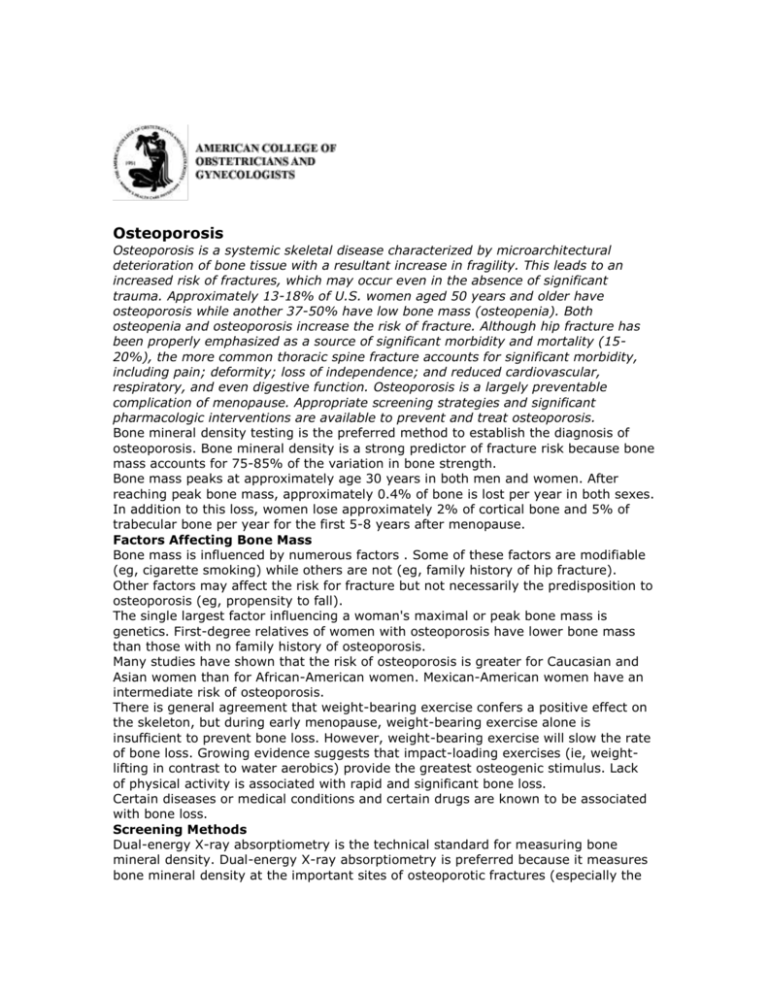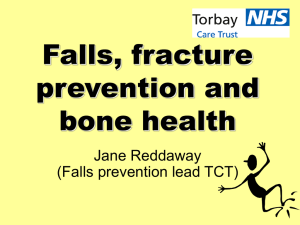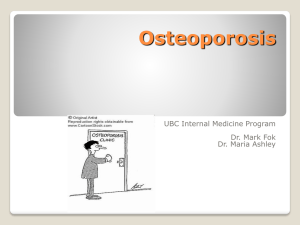
Osteoporosis
Osteoporosis is a systemic skeletal disease characterized by microarchitectural
deterioration of bone tissue with a resultant increase in fragility. This leads to an
increased risk of fractures, which may occur even in the absence of significant
trauma. Approximately 13-18% of U.S. women aged 50 years and older have
osteoporosis while another 37-50% have low bone mass (osteopenia). Both
osteopenia and osteoporosis increase the risk of fracture. Although hip fracture has
been properly emphasized as a source of significant morbidity and mortality (1520%), the more common thoracic spine fracture accounts for significant morbidity,
including pain; deformity; loss of independence; and reduced cardiovascular,
respiratory, and even digestive function. Osteoporosis is a largely preventable
complication of menopause. Appropriate screening strategies and significant
pharmacologic interventions are available to prevent and treat osteoporosis.
Bone mineral density testing is the preferred method to establish the diagnosis of
osteoporosis. Bone mineral density is a strong predictor of fracture risk because bone
mass accounts for 75-85% of the variation in bone strength.
Bone mass peaks at approximately age 30 years in both men and women. After
reaching peak bone mass, approximately 0.4% of bone is lost per year in both sexes.
In addition to this loss, women lose approximately 2% of cortical bone and 5% of
trabecular bone per year for the first 5-8 years after menopause.
Factors Affecting Bone Mass
Bone mass is influenced by numerous factors . Some of these factors are modifiable
(eg, cigarette smoking) while others are not (eg, family history of hip fracture).
Other factors may affect the risk for fracture but not necessarily the predisposition to
osteoporosis (eg, propensity to fall).
The single largest factor influencing a woman's maximal or peak bone mass is
genetics. First-degree relatives of women with osteoporosis have lower bone mass
than those with no family history of osteoporosis.
Many studies have shown that the risk of osteoporosis is greater for Caucasian and
Asian women than for African-American women. Mexican-American women have an
intermediate risk of osteoporosis.
There is general agreement that weight-bearing exercise confers a positive effect on
the skeleton, but during early menopause, weight-bearing exercise alone is
insufficient to prevent bone loss. However, weight-bearing exercise will slow the rate
of bone loss. Growing evidence suggests that impact-loading exercises (ie, weightlifting in contrast to water aerobics) provide the greatest osteogenic stimulus. Lack
of physical activity is associated with rapid and significant bone loss.
Certain diseases or medical conditions and certain drugs are known to be associated
with bone loss.
Screening Methods
Dual-energy X-ray absorptiometry is the technical standard for measuring bone
mineral density. Dual-energy X-ray absorptiometry is preferred because it measures
bone mineral density at the important sites of osteoporotic fractures (especially the
hip), is relatively inexpensive, has high precision and accuracy, and has modest
radiation exposure.
When should screening for osteoporosis be initiated?
Although not all experts or organizations agree, the following guidelines can be
recommended:
Bone mineral density testing should be recommended to all postmenopausal
women aged 65 years or older.
Bone mineral density testing may be recommended to postmenopausal
women younger than 65 years who have 1 or more risk factors for
osteoporosis.
Bone mineral density testing should be performed on all postmenopausal
women with fractures to confirm the diagnosis of osteoporosis and determine
disease severity.
Bone mineral density testing may be useful for premenopausal and postmenopausal
women with certain diseases or medical conditions and those who take certain drugs
associated with an increased risk of osteoporosis. In the absence of new risk factors,
subsequent screening should not be performed more frequently than every 2 years.
Can lifestyle changes prevent osteoporosis and osteoporosis-related
fractures?
Sedentary lifestyle is associated with reduced bone mass. The benefits of physical
exercise include maintenance of bone mass and an increase in muscle strength and
coordination.
The risk of falling increases substantially with aging. Diseases and sensory
impairments that can cause falling should be evaluated and treated (eg, a history of
falls, fainting, or loss of consciousness; muscle weakness, dizziness, or balance
problems; and impaired vision). Medications that reduce strength and balance (such
as sedatives, narcotic analgesics, anticholinergics, and antihypertensives) should be
avoided, if possible. The living environment should be monitored to reduce the risk of
falling. Safety hazards in the home and at work, such as loose rugs and carpets;
obstacles, especially to stairs; and poor lighting, should be assessed to reduce the
risks of falls. Individuals at risk should consider installing handrails in and around the
home.
Cessation of smoking and reducing alcohol intake may contribute to a decreased risk
of developing a fracture. Heavy alcohol consumption (defined as 7 oz or more per
week) has been shown to increase the risk for both falls and hip fracture. Excessive
alcohol consumption also has detrimental effects on bone mineral density. However,
moderate alcohol consumption in women aged 65 years and older is associated with
increased bone mineral density and lower risk for hip fracture.
Is there a role for estrogen and progestin for the prevention or treatment of
osteoporosis?
The Women's Health Initiative initial study results demonstrated a statistically
significant reduction in fractures, including hip fractures, in a large group of
otherwise healthy women using hormone therapy. A detailed analysis of the data
from this study has not been published to date, so it is not clear whether this was
truly a prevention or a treatment population.
Although the risks of long-term use of estrogen or hormone therapy are small, many
recommend such therapy be used for the shortest period at the lowest possible dose.
The Women's Health Initiative study indicated a significantly increased risk of
cardiovascular events and breast cancer for women taking combined estrogen and
progestin therapy. Thus, the use of hormone therapy for osteoporosis prevention or
fracture reduction should be evaluated based on an individual woman's history and
risk factors, including the need for treatment of vasomotor symptoms.
When estrogen therapy is discontinued, how should a woman be monitored
for osteoporosis risk?
When a woman discontinues estrogen therapy, risk assessment and screening should
follow the same criteria as for a woman who is in the early stages of menopause. It
also should take into account the need for bone mineral density measurements
based on age and other risk factors for osteoporosis.
Is other pharmacotherapy beneficial for the prevention and treatment of
osteoporosis?
In addition to estrogens, there are a number of agents available for the prevention of
osteoporosis. These can be broadly grouped into 2 categories: 1) bisphosphonates
(ie, alendronate, risedronate) and 2) selective estrogen receptor modulators (SERMs)
(ie, raloxifene, tibolone, tamoxifen).
Combinations of Antiresorptive Therapies
In women, calcium and vitamin D consumption are frequently inadequate. Doses
vary by source and chemical composition (eg, carbonate, citrate, gluconate), which
may affect bioavailability. The recommendations for these supplements apply to
elemental calcium. Care should be made to advise patients of the differences in
elemental calcium content (usually on the product label) in an attempt to make sure
they ultimately receive enough calcium.
Are complementary and alternative therapies beneficial for the prevention
of osteoporosis?
Although some data suggest that isoflavones (a class of phytoestrogens found in rich
supply in soy beans and soy products as well as in red clover) may favorably affect
bone health, few randomized, controlled clinical studies with humans have been
conducted, and those that have all involved small numbers of subjects in trials of
short duration.
When should treatment for osteoporosis begin and how should patients be
followed?
Lower bone mineral density T scores generally indicate more severe osteoporosis and
higher risk of fracture. Although few would withhold treatment from a women with
osteoporosis (T score less than -2.5), whether to treat a women with higher bone
density scores has become subject for debate. The controversy focuses on the
extremely low risk of fracture in young women with osteopenia and all women
without additional risk factors. The high costs and potential side effects of long-term
therapy until "old age," when fracture risk increases, has led many to suggest
withholding treatment until certain treatment thresholds have been reached.
Repeat DXA testing in untreated postmenopausal women typically is not useful until
3-5 years have passed because 5-year postmenopausal bone mineral density
reductions average only approximately 0.5 standard deviations from the mean (both
T scores and Z scores) in that time frame. For women receiving osteoporosis
therapy, bone mineral density monitoring before 2 years of therapy are completed
does not provide clinically useful information and may lead to erroneous assumptions
about the effect of therapy.
References available upon request.
This excerpt from ACOG's Practice Bulletin, Clinical Management Guidelines for
Obstetrician-Gynecologists Number 50, is provided for your information. It is not
medical advice and should not be relied upon as a substitute for visiting your doctor.
Copyright © January 2004 The American College of Obstetricians and Gynecologists. All rights reserved.









